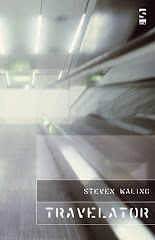I thought it would be interesting, before reading the book, to look at it as an object: as as thing to be handled. My friend John Calvert brought a copy round last night, though I don't personally have my own copy yet. So this is not a review of the content.
Firstly the cover. Like the recent anthology of young poets, Voice Recognition, but unlike the light blue livery of The New Poetry, this is a book clothed in black. This makes it look somewhat more serious, perhaps a little more Goth, and perhaps it reflects the more serious times. Voice Recognition has a picture of a lot of young people in a field, and Identity Parade has a rather strange picture of a piece of installation art or sculpture by Annette Messagger, with lots of eyes and faces in it. It's rather creepy, in fact: but it's striking, and on a shelf it would draw the eye toward it, if only to find out what it was.
It's a good cover, on the whole; and it speaks of the contents in two ways. Firstly, both covers emphasise the pluralism which the main theme of the anthology: neither anthology speaks of the single way forward for British poetry. But, whereas Voice Recognition emphasises youthfullness of its contents, Identity Parade emphasises its diversity. Both anthologies are serious (black livery) but Identity Parade is more so.
Both anthologies have interesting titles: one is taken from a piece of computer software; the other is a police line-up. They both suggest what might be one of the major themes of contemporary British poetry: namely, in this complex world of interlocking forces and competing markets, who am I, what am I responsible for? Am I just a blip on a cosmic computer screen?
And the book itself: a handy size, not too big, but big enough to look substantial. Looking inside (again, not really reading the content), the introduction doesn't overstay its welcome. Each poet is introduced seperately with a photo and some blurb, which actually seems useful because it gives an insight into each poet's method as well as their subjects. When Bloodaxe first did this I wasn't sure how helpful it was; but I have to put myself into the mind of someone who is only really discovering poetry through this anthology, and I think they would find it useful, though a definition of terms might have been useful: what exactly do terms such as traditional, mainstream and innovative mean?
So that's the book as a book: later, when I get my copy (anyone magazine like me to review it?) I can give my opinions on the actual poetry. But I think it's useful to ask questions about how it looks on the bookshelves at Waterstones, because that's where people will look at it, or not look at it. I think the rather creepy cover might put some off; but others (Gothy young people?) will find it intriguing enough to want to look in. I like it, personally.
A statement about my mother who has died
2 months ago

No comments:
Post a Comment